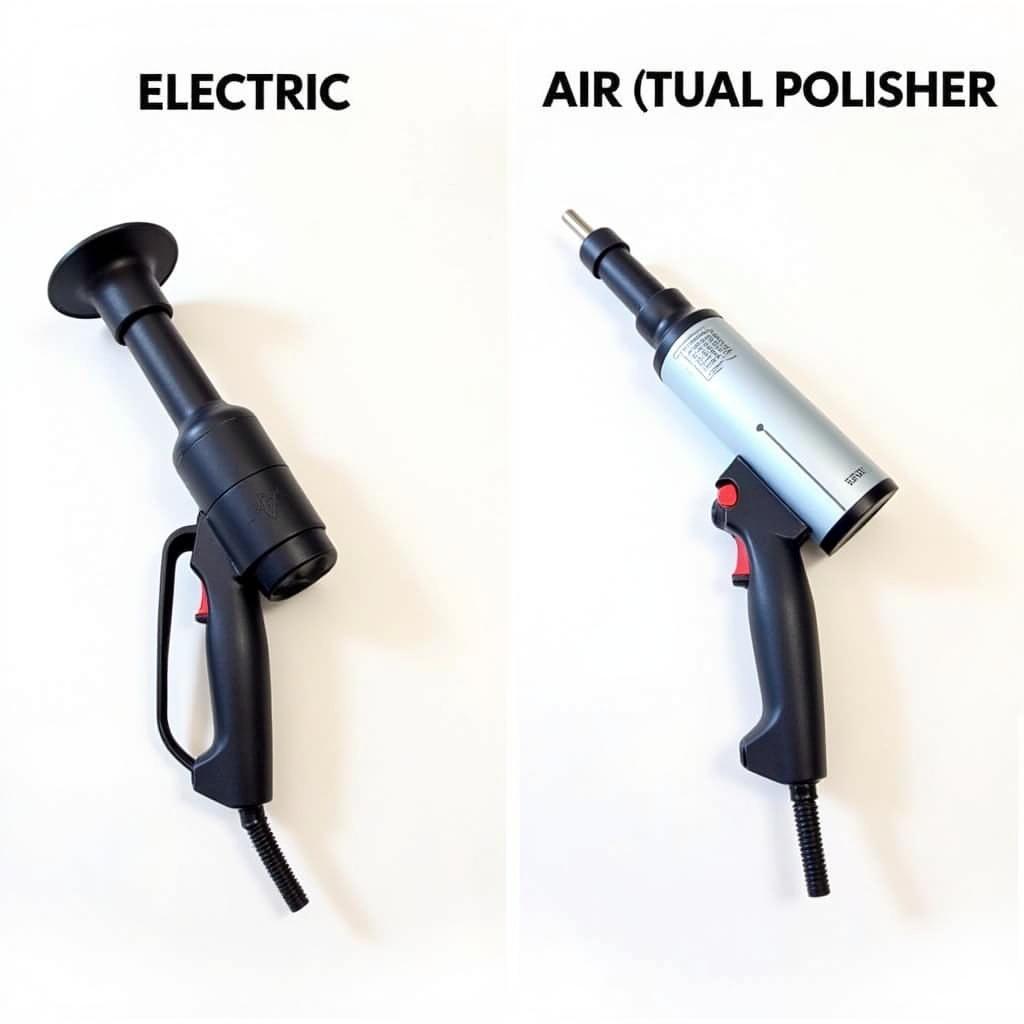Choosing the right polisher is crucial for achieving a flawless finish in car detailing. This article dives deep into the debate between electric and air-powered polishers, helping you determine the best tool for your needs, whether you’re a seasoned professional or a weekend warrior. We’ll explore the pros, cons, and key features of each type to empower you to make an informed decision.
Understanding the Power of Polishers: Electric vs. Air
Both electric and air-powered polishers serve the same purpose: to correct paint imperfections and enhance the shine of a vehicle’s finish. However, they differ significantly in their power source, operation, and overall performance. Understanding these differences is key to choosing the right tool for your detailing arsenal. What are the real advantages and disadvantages of each? Let’s find out!
Electric Polishers: Plug in and Polish
Electric polishers, often referred to as dual-action or rotary polishers, are powered by electricity, making them readily accessible and convenient. Dual-action polishers oscillate and rotate simultaneously, minimizing the risk of burning through paint, making them ideal for beginners. Rotary polishers, on the other hand, offer more aggressive cutting power for tackling deeper scratches and swirl marks, but require more experience and control. Electric polishers are versatile, portable, and generally more affordable than their air-powered counterparts.
Key benefits of electric polishers include consistent power delivery, ease of use, and portability. They are suitable for a wide range of detailing tasks, from light paint correction to removing heavy swirl marks. However, electric polishers can be heavier and bulkier than air-powered models, potentially causing fatigue during extended use.
Air Powered Polishers: Harnessing the Power of Compressed Air
Air-powered polishers, also known as pneumatic polishers, rely on compressed air to operate. These tools are favored by professional detailers for their lightweight design, high power output, and precise control. Air polishers typically offer smoother operation and produce less vibration than electric models, reducing operator fatigue and enhancing the overall detailing experience. However, they require an air compressor, which adds to the initial investment and limits portability.
The primary advantages of air-powered polishers are their lightweight nature, reduced vibration, and consistent speed under load. They are excellent for intricate detailing work and achieving a flawless finish. However, the need for an air compressor and associated hoses can be a drawback for some users.
Which Polisher is Right for You?
The best choice between an electric and air-powered polisher depends on several factors, including your skill level, budget, and detailing needs.
- Beginners: Electric dual-action polishers are generally the recommended starting point. Their forgiving nature and ease of use minimize the risk of damaging paint.
- Experienced Detailers: Both electric rotary and air-powered polishers are suitable for experienced users. Rotary polishers offer more aggressive cutting power, while air polishers provide superior control and reduced vibration.
- Mobile Detailers: Electric polishers are ideal for mobile detailing due to their portability and independence from an air compressor.
- Professional Detailing Shops: Air-powered polishers are often preferred in professional settings where consistent power and reduced vibration are essential.
“For beginners, I always recommend starting with an electric dual-action polisher,” says renowned detailing expert, Michael Schmidt. “They offer a great balance of power and control, allowing you to learn the basics without risking damage to the paint.”
 Comparing Electric and Air Polishers
Comparing Electric and Air Polishers
Electric vs. Air Powered Polisher: A Head-to-Head Comparison
| Feature | Electric Polisher | Air Powered Polisher |
|---|---|---|
| Power Source | Electricity | Compressed Air |
| Portability | High | Limited |
| Cost | Lower initial investment | Higher initial investment (compressor required) |
| Ease of Use | Generally easier for beginners | Requires more experience and control |
| Vibration | Can be higher | Lower |
| Weight | Heavier | Lighter |
| Maintenance | Lower | Higher |
“Once you’ve mastered the basics, an air-powered polisher can significantly elevate your detailing game,” adds Schmidt. “The reduced vibration and precise control allow for a truly flawless finish.” Another expert, Sarah Miller, emphasizes the importance of proper technique regardless of the polisher type: “The key to successful paint correction lies in understanding the principles of polishing, not just the tools themselves.”
Conclusion
Choosing between an electric and air-powered polisher for car detailing ultimately depends on your individual needs and preferences. By weighing the pros and cons of each, you can make an informed decision that empowers you to achieve professional-grade results. Both types of polishers offer unique advantages, and with proper technique, either can help you achieve a stunning, showroom-worthy finish.
FAQ
- What is the best polisher for a beginner? An electric dual-action polisher.
- Do I need an air compressor for an electric polisher? No.
- Are air-powered polishers more powerful than electric polishers? They generally offer smoother, more consistent power.
- Which type of polisher is better for mobile detailing? Electric polishers.
- What is the difference between a dual-action and rotary polisher? Dual-action oscillates and rotates, while rotary only rotates.
- Do I need special training to use a car polisher? While not required, training can significantly improve your results and prevent damage.
- Which type of polisher is easier to maintain? Electric polishers.
Need help with your car detailing project? Contact us via WhatsApp: +1(641)206-8880 or Email: [email protected]. Our 24/7 customer support team is ready to assist you.

Leave a Reply